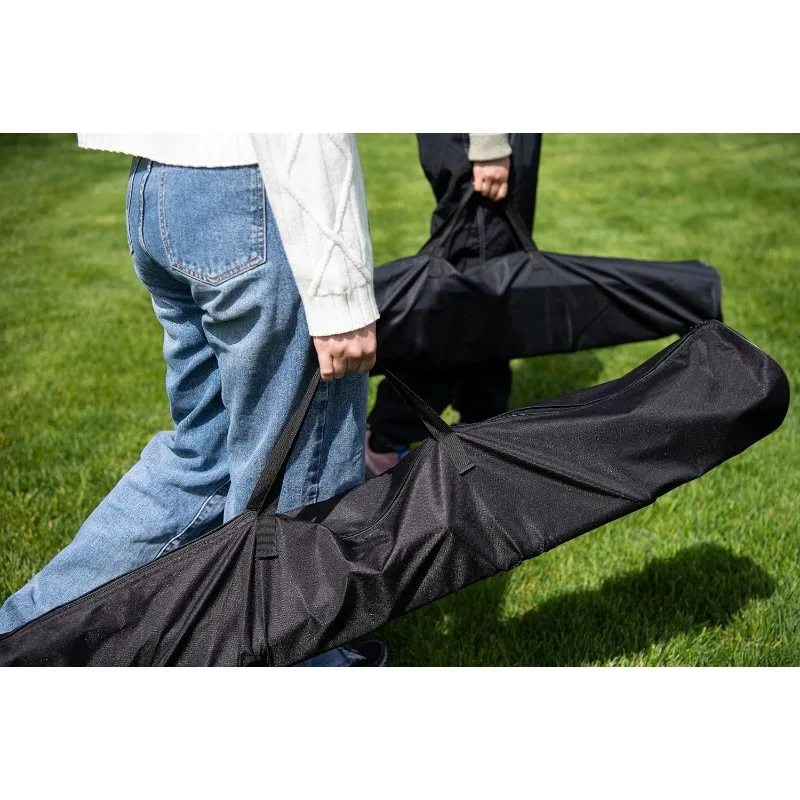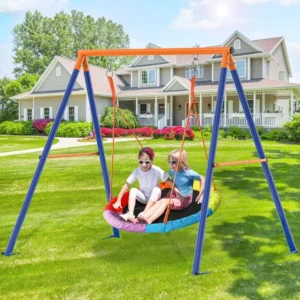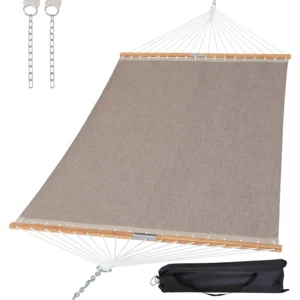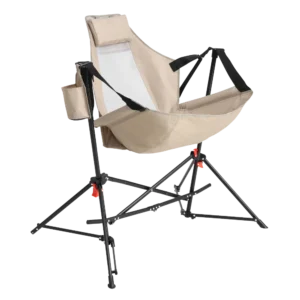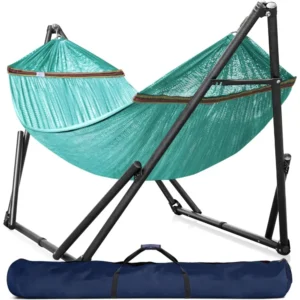Why Choose a Lightweight Folding Hammock for Your Outdoor Adventures
Lightweight folding hammocks represent a revolution in outdoor relaxation, offering the blissful comfort of traditional hammocks without the need for trees or permanent supports. These ingenious portable systems combine a collapsible frame with a comfortable hammock bed, creating a self-contained relaxation solution that goes wherever you do.
Unlike traditional hammocks that leave you searching for perfectly spaced trees, folding hammocks liberate you to relax in wide-open spaces like grassy parks, beach areas, and festival grounds. This solves the frustrating limitation of conventional hammocks, expanding your relaxation possibilities to virtually any flat outdoor surface.
The advantages extend well beyond just tree independence. These systems offer significant comfort upgrades compared to picnic blankets or portable chairs, elevating you off the ground away from insects, moisture, and uneven surfaces. Their portability means you can transform any outdoor gathering into a premium relaxation experience, whether you’re watching a soccer game, enjoying a concert in the park, or simply soaking up sunshine with friends.
The emotional payoff is substantial—imagine transforming any ordinary park visit into a personal retreat where you can fully recline in suspended comfort while others struggle with uncomfortable ground seating. Proper indoor and outdoor hammock placement enhances this experience further, allowing you to create your ideal relaxation environment anywhere.
For those interested in exploring options, our selection of folding hammock sets offers various designs to match different outdoor needs.
Essential Features to Consider When Choosing a Portable Hammock
When evaluating lightweight folding hammocks, understanding the key features that determine both performance and enjoyment will guide you toward the perfect match for your outdoor lifestyle.
The primary consideration is the delicate balance between portability and stability. A truly portable system should ideally weigh under 25 pounds (11.3 kg) while maintaining a sturdy foundation that won’t wobble or tip. This equilibrium represents the core engineering challenge manufacturers face—creating something light enough to carry comfortably yet stable enough to support an adult safely.
Beyond raw weight, consider these critical factors:
Folded dimensions: Look for systems that collapse to sizes manageable for transport in standard vehicles—ideally no larger than a folded camping chair. The most portable options fit into dedicated carrying bags with comfortable shoulder straps.
Frame materials: Aluminum frames offer the best weight-to-strength ratio, typically weighing 20-40% less than comparable steel frames while resisting rust. However, steel frames often provide greater stability and higher weight capacity, making them preferable for larger users.
Weight capacity: Most quality portable hammocks support between 250-500 pounds (113-227 kg). Always choose a capacity that exceeds your weight by at least 50 pounds for safety margin.
Setup mechanism: The best systems feature intuitive, tool-free assembly with minimal loose parts that could be lost in outdoor settings.
Understanding proper hammock installation requirements and safety guidelines ensures you’ll use your portable system correctly. For those prioritizing minimal weight, our collection of lightweight hammock sets offers excellent portable options without sacrificing critical stability features.
Understanding Weight Capacity and Stability for Safe Relaxation
Weight capacity encompasses more than simply supporting a person’s static weight—it reflects a hammock system’s ability to handle dynamic movement, shifting weight distribution, and occasional shared use. Manufacturers typically test their weight ratings with a significant safety margin, but staying well under the maximum rating provides greater long-term durability and stability.
Frame design directly impacts stability across different surfaces. The most versatile portable hammocks feature wider base footprints with adjustable feet that adapt to uneven ground. Look for bases that extend substantially beyond the hammock’s hanging points, creating a lower center of gravity that reduces tipping risk. Some premium models incorporate ground stakes for additional anchoring on soft surfaces like grass or sand.
Surface compatibility varies significantly between models. Basic designs work best on flat, firm surfaces like park lawns or patios. More advanced systems include articulating feet that adjust independently to accommodate modest slopes or uneven ground. For beach use, specialized wide-foot designs prevent sinking into soft sand.
Before fully reclining, always test stability by gradually applying weight and observing any frame flex or movement. Quality frames should feel rigid with minimal flexing when properly assembled. Pay particular attention to connection points—wobbliness often indicates misalignment or incomplete assembly rather than design flaws.
Quick Setup Systems: From Box to Relaxation in Minutes
The best portable hammocks transform from compact packages to ready-to-use relaxation systems in just minutes, with manufacturers continually refining their design for intuitive assembly. Understanding these setup mechanisms helps set realistic expectations for your outdoor experience.
Most contemporary folding hammocks utilize one of three primary setup approaches:
Snap-together systems use spring-loaded buttons and pre-connected frame segments that lock into position without tools. These typically assemble in 2-3 minutes after a brief learning curve, with most users mastering the process after 1-2 attempts.
Unfold-and-lock designs feature hinged connections that open like a book and secure with twist-locks or pin mechanisms. These represent the quickest assembly option, often ready in 60-90 seconds, but may sacrifice some stability compared to more complex setups.
Modular systems require connecting separate components in a specific sequence, taking slightly longer (4-5 minutes) but often delivering superior stability and customization options.
First-time assembly naturally takes longer as you familiarize yourself with the process, but most users report 50-75% faster setup times after their initial experience. The ingenuity behind quick setup hammock sets means you’ll spend less time assembling and more time relaxing.
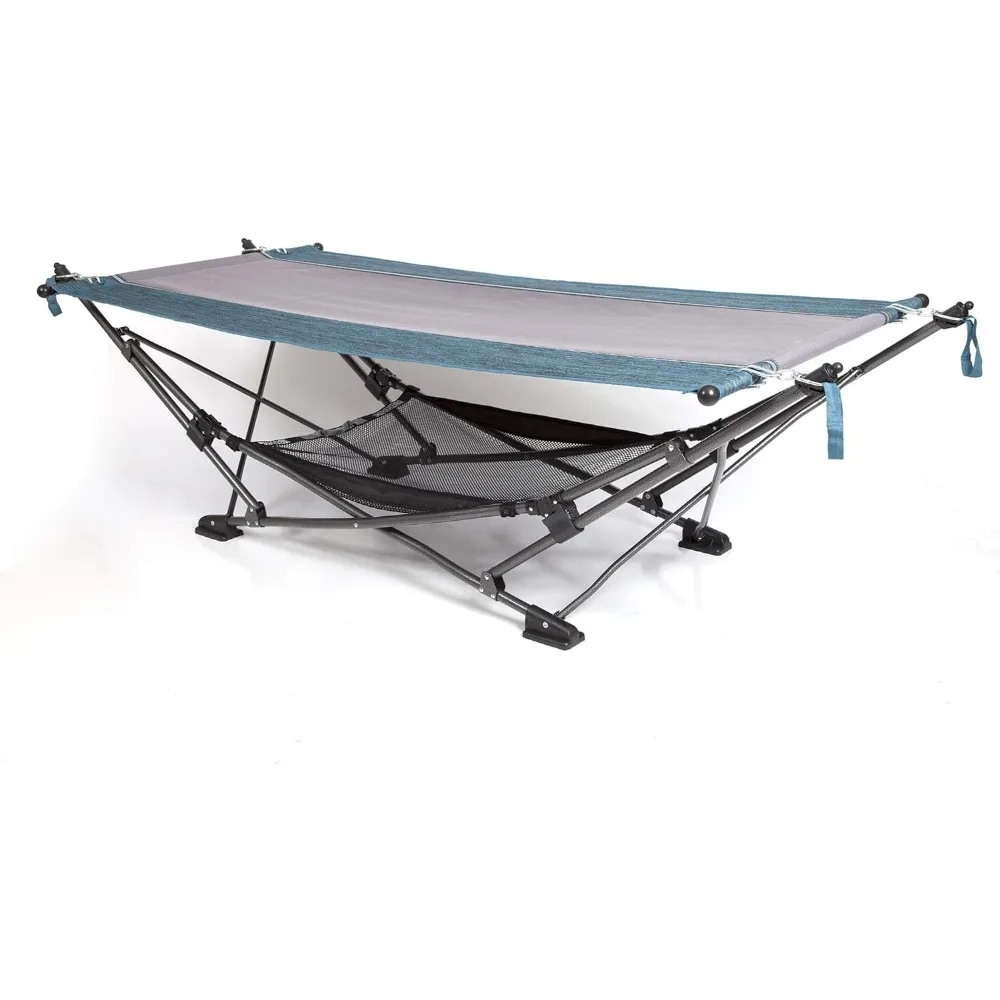
Learning to unfold your adventure with a folding hammock adds versatility to your outdoor recreation options, making spontaneous relaxation possible in virtually any setting.
Comfort Factors: What Makes a Portable Hammock Feel Luxurious
Despite their portable nature, today’s folding hammocks can deliver remarkable comfort that rivals traditional tree-hung options. Fabric quality emerges as the foremost comfort factor—look for tightly woven polyester or Sunbrella fabrics that combine durability with a soft touch against bare skin. The best materials balance breathability for summer use with sufficient density to prevent feeling every frame component underneath you.
Hammock bed dimensions critically impact comfort, particularly for taller users. Optimal dimensions typically start at 75 inches (190 cm) in length and 30 inches (76 cm) in width for single users, with premium options extending to 85+ inches (216+ cm) in length. This extra space allows for diagonal positioning—the secret to flat, ergonomic hammock lounging that eliminates excessive curve.
Tension adjustment capabilities separate basic models from superior designs. The ability to fine-tune the hammock’s tautness allows customization for different activities, from tighter tension for sitting upright to read, to looser settings for napping. Quality systems feature multiple attachment points or adjustable straps for personalized comfort tuning.
Ergonomic support depends on proper curve and tension. The ideal hammock creates a gentle 30-degree curve that supports your body’s natural contours without creating pressure points. Some models incorporate integrated head pillows, quilted padding, or spreader bars that enhance support while maintaining the essential hammock feel.
Understanding the best places to hang a hammock indoors can help you appreciate how these portable systems adapt comfort principles to outdoor settings.
The Balance Between Portability and Durability
Creating a lightweight hammock system inherently involves engineering compromises between portability and longevity. Understanding these trade-offs helps set realistic expectations for your investment.
Material selection represents the primary balancing point. Aircraft-grade aluminum offers superior weight savings (typically 3-4 pounds lighter than steel equivalents) while maintaining good durability, but may show wear at connection points sooner than steel alternatives. Premium aluminum frames incorporate reinforced joints and thicker-walled tubing at high-stress points to extend lifespan without significant weight penalties.
Weather resistance varies considerably between price points. Entry-level models often use powder-coated frames that resist rust initially but may show corrosion after repeated exposure to moisture. Higher-end systems utilize anodized aluminum or specialized marine-grade finishes that maintain integrity through multiple seasons of outdoor use.
Fabric durability correlates strongly with weight—lighter fabrics (below 150 denier) offer better portability but reduced resistance to abrasion and UV damage. The most balanced options use 180-220 denier polyester with UV inhibitors woven directly into the fabric rather than applied as coatings that can wear off.
Construction quality reveals itself through attention to detail: double-stitched seams, reinforced stress points, quality hardware, and precision-engineered connection points. These elements may add slight weight but dramatically extend usable lifespan.
Learning more about how folding hammocks transform portability can help you appreciate these engineering achievements that make outdoor relaxation more accessible than ever before.
Top 5 Lightweight Folding Hammocks for Parks and Picnics
After extensive hands-on testing in various outdoor environments, we’ve identified the standout portable hammock systems that deliver exceptional performance for park and picnic use. Our evaluation considered setup time, stability on different surfaces, comfort for extended lounging, and genuine portability.
Best Overall: The Horizon Breeze Portable System
This remarkably balanced system weighs just 19 pounds (8.6 kg) yet supports up to 350 pounds (159 kg). The aircraft-grade aluminum frame assembles in under 3 minutes through an intuitive snap-lock system requiring zero tools. We were particularly impressed by its stability on slight inclines and the quilted hammock bed that prevents uncomfortable pressure points during extended lounging.
Pros:
– Exceptional stability-to-weight ratio
– Quick-dry, UV-resistant fabric
– Includes integrated sunshade and side pocket
– Collapses to fit in a standard backpack
Cons:
– Premium price point
– Requires practice to master quick assembly
Most Portable: The Featherlight Travel Hammock
At just 12 pounds (5.4 kg), this ultralight option redefines portable relaxation. Despite its minimal weight, it supports up to 275 pounds (125 kg) and assembles in under 90 seconds. The innovative folding mechanism operates like an umbrella—simply pull apart and lock. While slightly less stable than heavier options, it excels for day trips where carrying comfort is paramount.
Pros:
– Lightest full-size option available
– Includes carrying case with comfortable shoulder straps
– Sets up faster than any competitor tested
– Surprisingly comfortable fabric despite lightweight materials
Cons:
– Limited weight capacity
– Less stable on uneven surfaces
Most Durable: The Expedition Heavy-Duty Portable Hammock
For those prioritizing longevity, this 24-pound (10.9 kg) system features a powder-coated steel frame with reinforced connection points rated for 500 pounds (227 kg). While heavier than aluminum alternatives, it demonstrated superior stability in windy conditions and showed zero wear after repeated assembly/disassembly cycles during our testing period.
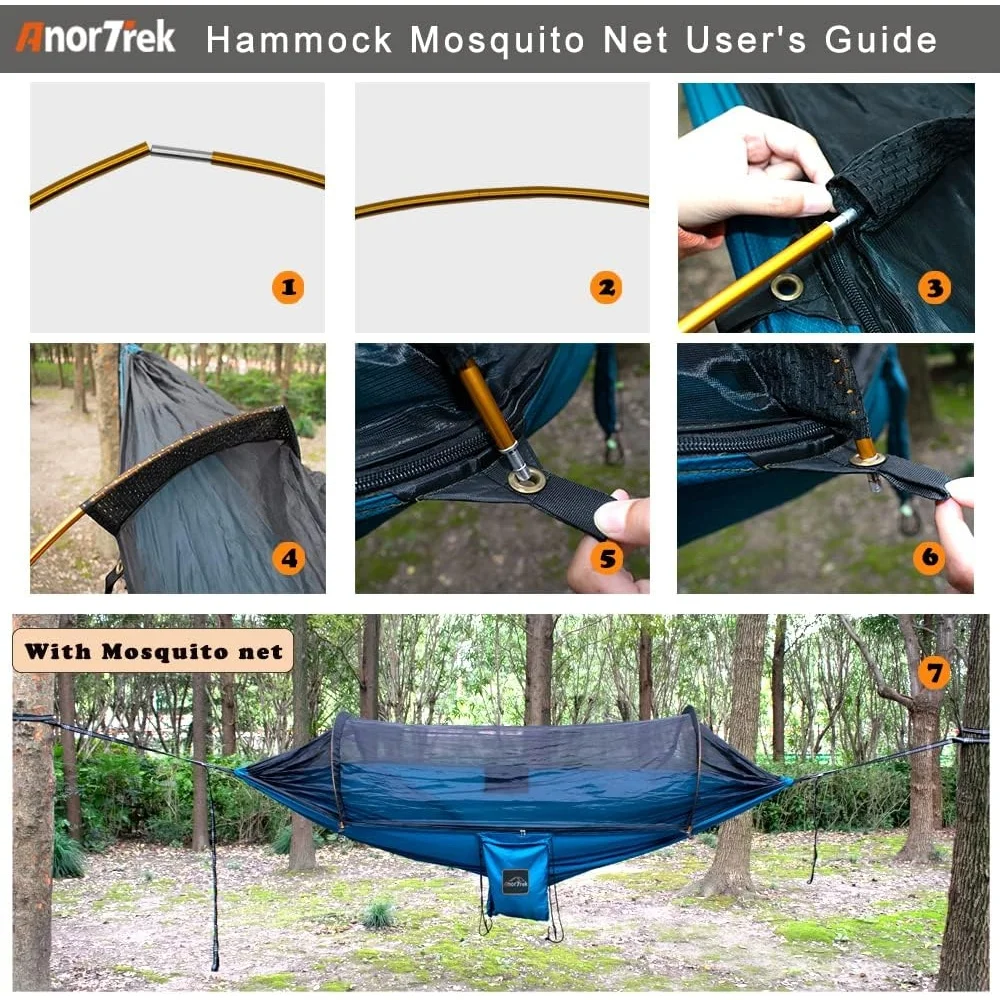
Folding Hammock Sets, Quick Setup Hammock Sets
Price range: $305.52 through $583.27 Select options This product has multiple variants. The options may be chosen on the product pageFolding Hammock Sets, Lightweight Hammock Sets
$295.80 Select options This product has multiple variants. The options may be chosen on the product pageDouble / Two Person Hammock Sets, Folding Hammock Sets, Heavy Duty Hammock Sets
Price range: $323.71 through $486.23 Select options This product has multiple variants. The options may be chosen on the product pageComplete Camping Hammock Systems, Folding Hammock Sets, Lightweight Hammock Sets, Quick Setup Hammock Sets
$255.54 Select options This product has multiple variants. The options may be chosen on the product pageComplete Camping Hammock Systems, Folding Hammock Sets, Lightweight Hammock Sets, Quick Setup Hammock Sets
$378.35 Select options This product has multiple variants. The options may be chosen on the product page
Our portable hammocks with stands collection includes options for every preference and budget, ensuring you’ll find the perfect match for your outdoor relaxation needs.
How to Choose the Perfect Spot for Your Portable Hammock
Selecting the ideal location for your folding hammock significantly enhances your relaxation experience. Start by seeking reasonably level ground—while most portable systems accommodate slight slopes, flatter surfaces provide optimal stability and comfort. Scan for hidden hazards like partially buried rocks or sticks that might destabilize your frame.
Consider sun positioning throughout your planned relaxation time. East-west orientation minimizes direct sunlight on your face as the sun moves. For longer sessions, seek locations with dappled shade or position yourself where trees will provide natural shade during peak sunlight hours without limiting your view.
Pay attention to surroundings and etiquette:
– Position at least 10 feet (3 meters) from walkways and high-traffic areas
– Avoid blocking scenic views that others might enjoy
– In crowded parks, orient your hammock to occupy minimal space
– Consider wind direction and seek natural windbreaks if available
For enhanced stability on grass, position your hammock frame perpendicular to any slope, with the hammock running downhill. This creates a more level lounging surface and reduces strain on the frame. On softer surfaces, periodically check frame stability as it may gradually sink during extended use.
Understanding perfect hammock placement for home and garden provides additional insights applicable to portable systems in public spaces.
Care and Maintenance for Long-Lasting Performance
Proper maintenance dramatically extends your portable hammock’s lifespan, protecting your investment and ensuring reliable performance season after season.
After each use, brush off loose debris and allow the fabric to dry completely before storage—even slight moisture can promote mildew growth in folded fabric. For stubborn dirt, use mild soap and lukewarm water with a soft brush, gently scrubbing the fabric while assembled to prevent cleaning solution from concentrating in fabric folds.
Frame care varies by material:
– Aluminum frames benefit from freshwater rinsing after exposure to salt (beach use) or chlorine (pool areas)
– Steel frames should be dried thoroughly and periodically checked for paint chips that could lead to rust
– All frames need connection points cleaned of sand or grit that could cause abrasion during setup/takedown
Inspect hardware before each use, tightening any loose connections. Apply silicone lubricant (never WD-40) to moving parts showing signs of stiffness. Store your system in its carrying case in a temperature-controlled environment rather than hot garages or damp basements.
Learning whether it’s okay to leave a hammock outside provides valuable context for understanding environmental factors affecting portable hammock longevity.
Enhancing Your Hammock Experience: Accessories and Add-ons
The right accessories transform a basic portable hammock into a comprehensive outdoor comfort system tailored to your specific needs.
Shade solutions represent the most popular enhancement category, with attachable canopies that mount directly to compatible frames offering the most integrated protection. Universal hammock umbrellas with clamp systems provide adaptable shade for hammocks lacking built-in attachment points. For maximum coverage, consider lightweight pop-up canopies positioned over your entire hammock system.
Convenience accessories elevate the practical aspects of hammock relaxation:
– Side tables with drink holders keep refreshments within reach
– Storage pockets attach to hammock edges for keeping books, devices, and sunscreen accessible
– Hammock stabilizer bars reduce swinging for activities like reading
– Battery-powered LED string lights create ambiance for evening relaxation
Comfort enhancements address the few limitations inherent to portable designs:
– Hammock pads add cushioning while insulating against cooler air below
– Specialized pillows with non-slip backing stay positioned properly
– Lightweight hammock blankets provide warmth for evening use
For uneven or soft terrain, ground stakes designed specifically for portable hammock frames add significant stability with minimal weight penalty. Look for models with Y-shaped designs that resist pulling out even in sandy soil.
Frequently Asked Questions About Lightweight Folding Hammocks
Can folding hammocks be used on beaches and sandy surfaces?
Yes, most folding hammocks work well on sand, though models with wider feet perform better by distributing weight to prevent sinking. Some users place small flat boards under each foot for additional stability. After beach use, thoroughly rinse all components with fresh water to prevent salt corrosion and sand abrasion.
What’s the difference between a folding hammock and a portable hammock stand?
A folding hammock is a complete system including both the stand and hammock bed designed to work together as a single unit. A portable hammock stand is a standalone frame compatible with traditional hammocks you already own. Folding hammocks typically offer faster setup but less customization, while portable stands provide flexibility to use different hammock styles.
How do aluminum frames compare to steel for durability?
Aluminum frames offer excellent corrosion resistance and lighter weight (typically 30-40% lighter than steel equivalents) but may bend under excessive weight or impact. Steel frames provide superior strength and resistance to deformation but are heavier and more susceptible to rust if the protective coating becomes damaged. For most users, aluminum’s weight advantage outweighs steel’s marginally better durability.

Are folding hammocks suitable for camping or primarily for day use?
While designed primarily for day use, many lightweight folding hammocks work well for camping on established sites. They excel at campgrounds where trees might be unavailable or prohibited for hammock hanging. However, their weight and packed size make them impractical for backpacking compared to traditional camping hammocks that weigh under 2 pounds.
How do I clean and maintain the fabric on my portable hammock?
Clean with mild soap and cold water using a soft brush for stubborn stains. Always allow the fabric to dry completely before storing to prevent mildew growth. UV protectant sprays designed for outdoor fabrics can extend color life and material strength for hammocks frequently used in direct sunlight.
Weather Considerations: Using Your Portable Hammock in Different Conditions
Weather significantly impacts your portable hammock experience, but understanding these factors helps you adapt and maximize enjoyment across different conditions.
In windy environments, position your hammock with the narrow profile facing the wind direction to minimize resistance. Most systems remain stable in light to moderate breezes (up to 10-15 mph), but gusty conditions warrant additional precautions. Some users add weight to the frame base or use dedicated wind stakes for extra stability. Always disassemble your hammock if winds exceed 20 mph to prevent damage or tipping.
Light rain needn’t end your relaxation—quick-drying synthetic fabrics shed water effectively, though comfort diminishes on wet surfaces. Consider water-resistant hammock blankets that insulate from moisture. For sunny days, position your hammock to utilize morning or late afternoon sun when UV intensity decreases, or add a shade attachment for midday protection.
Seasonal conditions present unique considerations. Spring often brings muddy ground that can compromise frame stability—use flat pieces of wood under feet to distribute weight. Summer heat radiates from ground surfaces, making hammocks significantly cooler than ground seating. Fall leaves and debris should be brushed off before folding to prevent staining and mildew.
Always pack a microfiber towel for wiping down surfaces after unexpected weather changes. This simple preparation ensures you can quickly dry your hammock after a passing shower or morning dew, extending your comfortable relaxation time.

